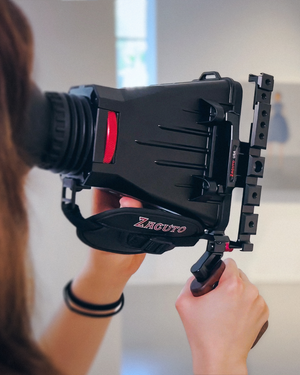
How to power your EVF?

It can be easy to leave your electronic viewfinder’s power supply as an afterthought, only to find that the solution requires more attention than you initially realized. Whether you’re simply a hobbyist or a filmmaking professional who relies on this equipment to power your business, understanding EVF power is crucial for making the most out of your investment.
So, what exactly do you need to know about this product, how can you keep it powered to fit your needs, and which electronic viewfinder power banks are the best for your camera? Stick around to find out!
What is an Electronic Viewfinder?
Even if you know relatively little about cameras, the name “viewfinder” probably sounds familiar. This is the component that enables the user to visually see what area they will capture prior to taking or recording the image.
Still, there comes a time when these stock options require a boost to enhance the final product or when a camera is missing a viewfinder altogether. Skilled users often opt for an electronic viewfinder (EVF) that stays the same no matter the camera you pick up to shoot with to help elevate their craft.

These allow the user to view images through a small digital display (different from traditional mirror-and-prism optical viewfinders), which contains a built-in shade to protect it from ambient light. With an EVF, photographers and filmmakers can look forward to taking more accurate, aesthetically pleasing shoots thanks to the guidance it provides.
How Do I Power My Electronic Viewfinder?
Since EVFs are electronic products, they require a steady power supply to keep them active. Fortunately, finding quality EVF power is easy and options are plentiful depending on your camera rig setup. With that being said, not every EVF is made the same: you’ll need to pick up an electronic viewfinder power supply according to the unique specifications of your product. We can split these up into two categories: Internal Power & External Power.
Internal Power
EVFs that have internal power are often the most convenient when it comes to overall use, as you won’t need to worry about acquiring external power packs. However, they are also generally larger in size, which could be a drawback depending on your requirements.
We can look at the ACT EVF Pro and (now discontinued) Zacuto Gratical HD EVF as an example. Though incredibly powerful, these products might be a bit too big for some users.

External Power
Alternatively, you could go for another form of EVF power: external. As the name suggests, products like the best-selling Kameleon Pro EVF and Gratical Eye will need external battery packs to keep them juiced during your recording sections.



For rigs, system batteries like the Gripper 75W battery and battery plates like the Zwiss Plate can be attached directly to your equipment. They are also suitable for stress-free transportation. However, mounting professional batteries are not always idea when trying to keep rigs light and compact. We have the perfect solution when trying to stay small and lightweight- Gratical Eye and Kameleon EVF power adapters.


The power adapter provides an LP-E6 battery mount for powering the Gratical Eye EVF or Kameleon EVF. This lightweight, integrated design mounts to the side of the EVF using the rosette mount. A 2 pin Lemo (or 4 pin Lemo) provides power from the battery plate into the lemo pin power input, and a power switch allows you to switch power on/off. Simple, Small and Lightweight. A must have for your camera bag!


Leave a comment